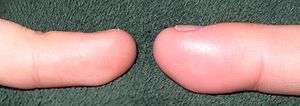Paronychia
Paronychia is a nail disease that is an often tender bacterial or fungal infection of the hand or foot, where the nail and skin meet at the side or the base of a finger or toenail. The infection can start suddenly (acute paronychia) or gradually (chronic paronychia).[2][3] Paronychia is commonly misapplied as a synonym for whitlow or felon. The term is from Greek: παρωνυχία from para, "around", onyx, "nail" and the abstract noun suffix -ia.[4][5]
| Paronychia | |
|---|---|
| Other names | Infection - skin around the nail[1] |
 | |
| Specialty | Dermatology, emergency medicine |
Signs and symptoms
The skin typically presents as red, itchy, and hot, along with intense pain. Pus is usually present, along with gradual thickening and browning discoloration of the nail plate.
Cause
Acute paronychia is usually caused by bacteria. Paronychia is often treated with antibiotics, either topical or oral or both. Chronic paronychia is most often caused by a yeast infection of the soft tissues around the nail but can also be traced to a bacterial infection. If the infection is continuous, the cause is often fungal and needs antifungal cream or paint to be treated.[6]
Risk factors include repeatedly washing hands and trauma to the cuticle such as may occur from repeated nail biting. In the context of bartending, it is known as bar rot.[7]
Prosector's paronychia is a primary inoculation of tuberculosis of the skin and nails, named after its association with prosectors, who prepare specimens for dissection. Paronychia around the entire nail is sometimes referred to as runaround paronychia.
Painful paronychia in association with a scaly, erythematous, keratotic rash (papules and plaques) of the ears, nose, fingers, and toes may be indicative of acrokeratosis paraneoplastica, which is associated with squamous cell carcinoma of the larynx.[8]
Paronychia can occur with diabetes, drug-induced immunosuppression,[9] or systemic diseases such as pemphigus.[10]
Diagnosis
Types

Paronychia may be divided as follows:[11]
- Acute paronychia is an infection of the folds of tissue surrounding the nail of a finger or, less commonly, a toe, lasting less than six weeks.[3] The infection generally starts in the paronychium at the side of the nail, with local redness, swelling, and pain.[12]:660 Acute paronychia is usually caused by direct or indirect trauma to the cuticle or nail fold, and may be from relatively minor events, such as dishwashing, an injury from a splinter or thorn, nail biting, biting or picking at a hangnail, finger sucking, an ingrown nail, or manicure procedures.[13]:339
- Chronic paronychia is an infection of the folds of tissue surrounding the nail of a finger or, less commonly, a toe, lasting more than six weeks.[3] It is a nail disease prevalent in individuals whose hands or feet are subject to moist local environments, and is often due to contact dermatitis.[12]:660 In chronic paronychia, the cuticle separates from the nail plate, leaving the region between the proximal nail fold and the nail plate vulnerable to infection.[14]:343 It can be the result of dish washing, finger sucking, aggressively trimming the cuticles, or frequent contact with chemicals (mild alkalis, acids, etc.).
Alternatively, paronychia may be divided as follows:[12]
- Candidal paronychia is an inflammation of the nail fold produced by Candida albicans.[11]:310
- Pyogenic paronychia is an inflammation of the folds of skin surrounding the nail caused by bacteria.[11]:254 Generally acute paronychia is a pyogenic paronychia as it is usually caused by a bacterial infection.[3]
Treatment
When no pus is present, warm soaks for acute paronychia are reasonable, even though there is a lack of evidence to support its use.[15] Antibiotics such as clindamycin or cephalexin are also often used, the first being more effective in areas where MRSA is common.[15] If there are signs of an abscess (the presence of pus) drainage is recommended.[15]
Chronic paronychia is treated by avoiding whatever is causing it, a topical antifungal, and a topical steroid.[16] In those who do not improve following these measures, oral antifungals and steroids may be used or the nail fold may be removed surgically.[16]
References
- "Paronychia: MedlinePlus Medical Encyclopedia". medlineplus.gov. Retrieved 26 April 2019.
- Rigopoulos D, Larios G, Gregoriou S, Alevizos A (February 2008). "Acute and chronic paronychia". Am Fam Physician. 77 (3): 339–46. PMID 18297959.
- Rockwell PG (March 2001). "Acute and chronic paronychia". Am Fam Physician. 63 (6): 1113–6. PMID 11277548.
- Harper, Douglas. "paronychia". Online Etymology Dictionary.
- παρωνυχία, παρά, ὄνυξ. Liddell, Henry George; Scott, Robert; A Greek–English Lexicon at the Perseus Project.
- "Doctor's advice Q: Whitlow (paronychia)". bbc.co.uk. Retrieved 2008-05-10.
- "Bar Rot". The Truth About Bartending. January 27, 2012. Archived from the original on 2013-03-22.
- Karen Allen, MD (2005-08-17). "eMedicine - Acrokeratosis Neoplastica". Cite journal requires
|journal=(help) - Paronychia~clinical at eMedicine
- Serratos BD, Rashid RM (200). "Nail disease in pemphigus vulgaris". Dermatol. Online J. 15 (7): 2. PMID 19903430.
- James, William D.; Berger, Timothy G. (2006). Andrews' Diseases of the Skin: clinical Dermatology. Saunders Elsevier. ISBN 978-0-7216-2921-6.
- Freedberg, Irwin M., ed. (2003). Fitzpatrick's Dermatology in General Medicine (6th ed.). McGraw-Hill Publishing Company. ISBN 978-0071380768.
- Rigopoulos, Dimitris; Larios, George; Gregoriou, Stamatis; Alevizos, Alevizos (2008). "Acute and Chronic Paronychia" (PDF). American Family Physician. 77 (3): 339–346. PMID 18297959. Retrieved January 7, 2013.
- Rigopoulos, Dimitris; Larios, George; Gregoriou, Stamatis; Alevizos, Alevizos (2008). "Acute and Chronic Paronychia" (PDF). American Family Physician. 77 (3): 339–346. PMID 18297959. Retrieved January 8, 2013.
- Ritting, AW; O'Malley, MP; Rodner, CM (May 2012). "Acute paronychia". The Journal of Hand Surgery. 37 (5): 1068–70, quiz page 1070. doi:10.1016/j.jhsa.2011.11.021. PMID 22305431.
- Rigopoulos, D; Larios, G; Gregoriou, S; Alevizos, A (Feb 1, 2008). "Acute and chronic paronychia". American Family Physician. 77 (3): 339–46. PMID 18297959.
External links
| Classification | |
|---|---|
| External resources |
| Wikimedia Commons has media related to Paronychia (disease). |
- "Paronychia Nail Infection". Dermatologic Disease Database. American Osteopathic College of Dermatology. Retrieved 2006-07-12.